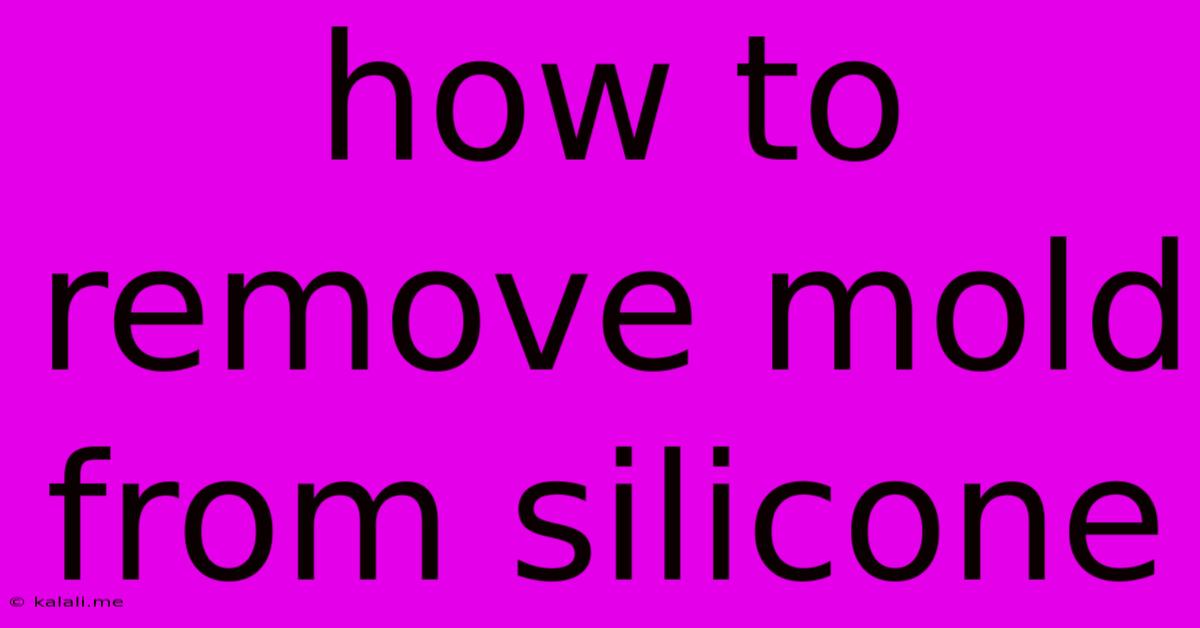How To Remove Mold From Silicone
Kalali
Jun 06, 2025 · 3 min read

Table of Contents
How to Remove Mold from Silicone: A Comprehensive Guide
Mold growth on silicone products is a common problem, especially in damp environments. Whether it's your silicone baking mat, your favorite silicone kitchen utensil, or a silicone phone case, dealing with mold can be frustrating. This guide provides a step-by-step approach on how to effectively remove mold from silicone, ensuring your items are safe and clean.
Why is mold removal from silicone important? Mold can cause unpleasant odors and potentially pose health risks, making prompt removal crucial. Ignoring mold growth can lead to further contamination and damage to your silicone items. This article will cover effective cleaning methods for various silicone products, addressing different levels of mold infestation.
Assessing the Mold Infestation
Before starting the cleaning process, it's vital to assess the extent of the mold growth. A small amount of surface mold is easier to remove than a deeply embedded infestation.
- Mild Mold: This involves small patches of mold that are easily visible.
- Moderate Mold: Mold covers a larger surface area but hasn't deeply penetrated the silicone.
- Severe Mold: Extensive mold growth with potential deep penetration requiring more rigorous cleaning methods.
Cleaning Methods for Removing Mold from Silicone
The cleaning method you choose will depend on the severity of the mold and the type of silicone product.
Method 1: Gentle Cleaning for Mild Mold Infestation
This method is suitable for lightly soiled silicone items with minor mold spots.
- Preparation: Gather your cleaning supplies: a soft-bristled brush (old toothbrush works well), warm soapy water (mild dish soap is sufficient), and a clean cloth or sponge.
- Cleaning: Gently scrub the affected area with the soapy water and brush. Rinse thoroughly with clean water.
- Drying: Air dry the silicone item completely. Direct sunlight can help speed up the drying process and inhibit further mold growth.
Method 2: Intermediate Cleaning for Moderate Mold Infestation
This method is suitable for silicone items with more widespread mold but without deep penetration.
- Preparation: Gather your supplies: a mixture of equal parts white vinegar and water, a soft-bristled brush, a clean cloth or sponge, and baking soda (optional).
- Cleaning: Soak the silicone item in the vinegar solution for about 30 minutes. Scrub gently with the brush to loosen the mold. For stubborn mold, make a paste of baking soda and water, apply it to the affected areas, and gently scrub. Rinse thoroughly.
- Drying: Air dry completely.
Method 3: Deep Cleaning for Severe Mold Infestation
This method is for silicone items with significant mold growth, requiring more aggressive cleaning.
- Preparation: Gather your supplies: a bleach solution (1 part bleach to 10 parts water – use caution when handling bleach), protective gloves, a soft-bristled brush, a clean cloth or sponge, and safety glasses.
- Cleaning: Always wear protective gloves and eyewear when handling bleach. Soak the silicone item in the bleach solution for no longer than 30 minutes. Scrub gently with the brush, paying attention to affected areas. Rinse very thoroughly with clean water. Repeat if necessary.
- Drying: Air dry completely in a well-ventilated area, away from direct sunlight.
Preventing Future Mold Growth
Once you've cleaned your silicone items, take steps to prevent future mold growth:
- Proper Drying: Ensure silicone items are completely dry after each use.
- Storage: Store silicone items in a cool, dry, and well-ventilated area.
- Regular Cleaning: Clean silicone items regularly to prevent mold buildup.
Important Considerations:
- Material Compatibility: Always test any cleaning solution on a small, inconspicuous area before applying it to the entire surface.
- Heat Resistance: Avoid using extremely hot water or harsh chemicals that could damage the silicone.
- Disposal: If the mold infestation is severe and cleaning is ineffective, it's best to discard the silicone item.
By following these methods and preventative measures, you can effectively remove mold from your silicone products and keep them clean and safe for use. Remember to always prioritize safety and use appropriate protective gear when handling harsh chemicals.
Latest Posts
Latest Posts
-
Another Word For Getting Someone Angry
Jun 07, 2025
-
Denver To Salt Lake City Drive
Jun 07, 2025
-
What Size Wire For 150 Amp Service
Jun 07, 2025
-
How To Make A Picture Transparent In Google Slides
Jun 07, 2025
-
How Much Does A Russet Potato Weigh
Jun 07, 2025
Related Post
Thank you for visiting our website which covers about How To Remove Mold From Silicone . We hope the information provided has been useful to you. Feel free to contact us if you have any questions or need further assistance. See you next time and don't miss to bookmark.